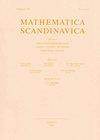关于图的边理想的小符号幂的正则性
IF 0.7
4区 数学
Q4 MATHEMATICS
引用次数: 1
摘要
假设$G$是一个具有边理想$I(G)$的图,并且让$I(G)^{(s)}$表示$I(G$的符号次幂。证明了对于每一个整数$s\geq1$,$$\mathrm{reg}(I(G)^{(s+1)}因此,我们得出结论,$\mathrm{reg}(I(G)^{(2)})\leq\mathrm{reg}(I(G))+2$和$\mathrm{reg}。此外,还证明了如果对于某个整数$k\geq1$,图$G$至多没有长度为$2k-1$的奇循环,那么对于每个整数$s\leqk+1$,$\mathrm{reg}(I(G)^{(s)})\leq2s+\mathrm{reg}(I(G))-2$。最后,证明了$\mathrm{reg}(I(G)^{(s)})=2s$,对于$s\in\{2,3,4\}$,条件是补图$\overline{G}$是弦的。本文章由计算机程序翻译,如有差异,请以英文原文为准。
On the regularity of small symbolic powers of edge ideals of graphs
Assume that $G$ is a graph with edge ideal $I(G)$ and let $I(G)^{(s)}$ denote the $s$-th symbolic power of $I(G)$. It is proved that for every integer $s\geq 1$, $$ \mathrm{reg} (I(G)^{(s+1)})\leq \max \bigl \{\mathrm{reg} (I(G))$$ $$+2s, \mathrm{reg} \bigl (I(G)^{(s+1)}+I(G)^s\bigr )\bigr \}. $$ As a consequence, we conclude that $\mathrm{reg} (I(G)^{(2)})\leq \mathrm{reg} (I(G))+2$, and $\mathrm{reg} (I(G)^{(3)})\leq \mathrm{reg} (I(G))+4$. Moreover, it is shown that if for some integer $k\geq 1$, the graph $G$ has no odd cycle of length at most $2k-1$, then $\mathrm{reg} (I(G)^{(s)})\leq 2s+\mathrm{reg} (I(G))-2$, for every integer $s\leq k+1$. Finally, it is proven that $\mathrm{reg} (I(G)^{(s)})=2s$, for $s\in \{2, 3, 4\}$, provided that the complementary graph $\overline {G}$ is chordal.
求助全文
通过发布文献求助,成功后即可免费获取论文全文。
去求助
来源期刊

Mathematica Scandinavica
数学-数学
CiteScore
0.60
自引率
0.00%
发文量
19
审稿时长
>12 weeks
期刊介绍:
Mathematica Scandinavica is a peer-reviewed journal in mathematics that has been published regularly since 1953. Mathematica Scandinavica is run on a non-profit basis by the five mathematical societies in Scandinavia. It is the aim of the journal to publish high quality mathematical articles of moderate length.
Mathematica Scandinavica publishes about 640 pages per year. For 2020, these will be published as one volume consisting of 3 issues (of 160, 240 and 240 pages, respectively), enabling a slight increase in article pages compared to previous years. The journal aims to publish the first issue by the end of March. Subsequent issues will follow at intervals of approximately 4 months.
All back volumes are available in paper and online from 1953. There is free access to online articles more than five years old.
 求助内容:
求助内容: 应助结果提醒方式:
应助结果提醒方式:


